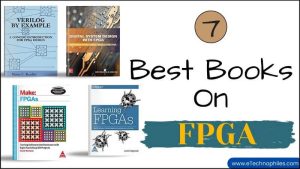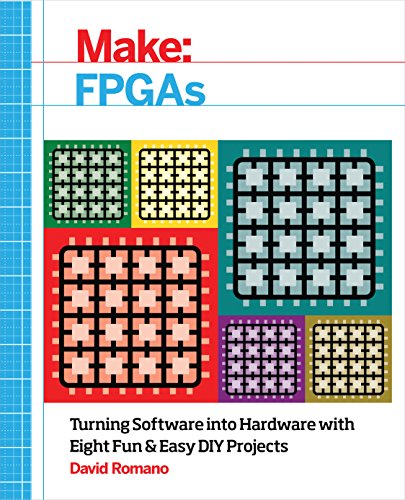Last updated on April 1st, 2024 at 04:12 pm
Field Programmable Gate Arrays (FPGAs) are integrated circuits made of semiconductors that can be configured according to the choice of a manufacturer. They are used to modify already existing systems, whenever necessary.
If you are curious about FPGAs, start by gathering some solid informative reading material about them. We can help you out there, as we have prepared a list of the 7 best books on FPGA.
List of 7 Best Books on FPGA
Which is the best overall book on FPGA? (Our pick)
The overall best book on the FPGA is Verilog by Example: A Concise Introduction for FPGA Design by Blaine C. Readler . Apart from the basics, the book also covers the topics essential for effective design and implementation. These include simulation, test benches, and high-level synthesis. The book also has code examples that serve as valuable resources that readers can refer to as they develop their designs.
Which is the best FPGA book for Beginners? (Our pick)
If you are a beginner, we must recommend you Programming FPGAs: Getting Started with Verilog by Simon Monk . The book first gives an overview of digital logic and circuitry, before moving on to more advanced topics such as Verilog and VHDL.
The use of practical examples to illustrate key concepts is what gives the readers an additional advantage. The author provides clear and concise explanations of different concepts throughout the book. He also gives the potential benefits and drawbacks.
Verilog by Example: A Concise Introduction for FPGA Design
If you are looking for a book on FPGA that focuses on Verilog then this book is ideal for you. It’s a practical book that will give you hands-on experience.
Key Features:
- A step-by-step description of Verilog
- Easy-to-understand examples
- All features of Verilog are covered
- Design real-world FPGA solutions
- All sample codes used in the book are available online
Ideal for: Students and Practicing Engineers
Not ideal for: Readers unfamiliar with the basics of digital design
Number of pages: 124
Number of chapters: 11
Digital System Design with FPGA: Implementation Using Verilog and VHDL
This book focuses on Verilog and VHDL. You will gain insights on how to use both these hardware description languages for FPGA digital system design.
Key Features:
- Develop and deploy systems based on FPGA
- Principles, practices, and applications
- Use Basys and Arty boards to create inexpensive projects
- Soft-core microcontroller and digital interfacing
Ideal for: Beginners
Not ideal for: Children
Number of pages: 400
Number of chapters: 14
Learning FPGAs: Digital Design for Beginners with Mojo and Lucid HDL
Do you want to program FPGA using some other hardware description language than Verilog? Then try using Mojo and Lucid languages with the help of this book.
Key Features:
- Design digital circuits
- Design your processor
- Use Xilinx ISE to create hardware designs
- Fully colored and illustrated images and screenshots to help you grasp things better
- Dedicated chapters on sequential and combinational logic
Ideal for: Readers with basic background knowledge of digital hardware design
Not ideal for: AbsoluteBeginners
Number of pages: 230
Number of chapters: 13
Make: FPGAs: Turning Software into Hardware with Eight Fun and Easy DIY Projects
If you are someone who enjoys designing things then you sure will enjoy this book. It will tell you how to design DIY hardware projects with the help of software.
Key Features:
- Learn to break down a complex problem into simpler problems that can be solved with FPGA
- Design logic to run on your FPGA
- Connect electronic components to create a complete project
- 8 very simple DIY projects
Ideal for: Beginners just starting with FPGA
Not ideal for: Advanced Readers
Number of pages: 345
Number of chapters: 20
Programming FPGAs: Getting Started with Verilog
If you are already acquainted with FPGAs and want to get started on building things with this technology then this book could be an excellent guide for you. You will learn it with clear and easy-to-follow examples in this book.
Key Features:
- Basics of digital logic and digital electronics
- Use of Mojo, Elbert 2, and Papilio boards
- Use ISE Design Suite
- Downloadable source codes and finished bit files
- Build projects like memory-mapped video displays, timers, tone generators, LED decoders, etc
Ideal for: Professional Developers and Hobbyists
Not ideal for: Beginners
Number of pages: 192
Number of chapters: 10
100 Power Tips for FPGA Designers
Unlike all the other books on the list, this book is not in the form of a reference book or a textbook. This book is full of short articles on multiple topics of FPGA. You will find interesting and useful information on different aspects of FPGAs.
Key Features:
- Full of illustrations and code examples
- Focus on FPGA families like Xilinx Virtex-6 and Spartan-6
- Verilog HDL is used for coding
- Topics include synthesis, simulation, porting ASIC designs, floorplanning and timing closure, design methodologies, performance, area, and power optimizations, RTL coding, IP core selection, etc
Ideal for: Students, System Architects, and Design Engineers
Not ideal for: Children
Number of pages: 476
Number of chapters: 12
FPGA Programming for Beginners
Developing skills is an important part of learning anything. This book will help you develop skills that can be applied to design systems with this technology.
Key Features:
- Explore FPGA usage methods
- Understand tool flow
- Use SystemVerilog to design, implement, and test hardware circuits
- Use FPGA resources to build real-world projects
- Learn Xilinx architectures
Ideal for: Beginners
Not ideal for: Children
Number of pages: 368
Number of chapters: 11
Don’t ever hold yourself back from doing something just because it’s new to you. The same goes for learning about things like FPGA. Be calm and gently follow the works that are laid in front of you. This list is your best friend if you are determined to learn about FPGAs and build advanced and complex projects with them.
To get you started with FPGA, we suggest you purchase Programming FPGAs: Getting Started with Verilog by Simon Monk. It will get you started right from what FPGAs are to how you can use them to solve real-world problems. Since it’s for beginners so it doesn’t cover a lot of advanced topics. For that, you can refer to Verilog by Example: A Concise Introduction for FPGA Design by Blaine C. Readler.















